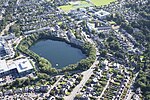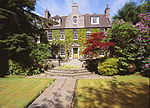Springbank Cemetery, Aberdeen
AberdeenCemeteries in Scotland

Springbank Cemetery is located on Countesswells Road, Aberdeen. It opened in 1884. The cemetery is operated by the local authority, Aberdeen City Council, is one of seventeen cemeteries in Aberdeen. It is located on Countesswells Road with entrances on both Countesswells Road and Springfield Road where the cemetery lodge is situated. According to Historic Environment Scotland, at the south-west corner of the cemetery there formerly stood Springbank Cottage.
Excerpt from the Wikipedia article Springbank Cemetery, Aberdeen (License: CC BY-SA 3.0, Authors, Images).Springbank Cemetery, Aberdeen
Countesswells Road, Aberdeen City Mannofield
Geographical coordinates (GPS) Address Nearby Places Show on map
Geographical coordinates (GPS)
| Latitude | Longitude |
|---|---|
| N 57.1320007 ° | E -2.146368 ° |
Address
Countesswells Road
Countesswells Road
AB15 7XU Aberdeen City, Mannofield
Scotland, United Kingdom
Open on Google Maps








